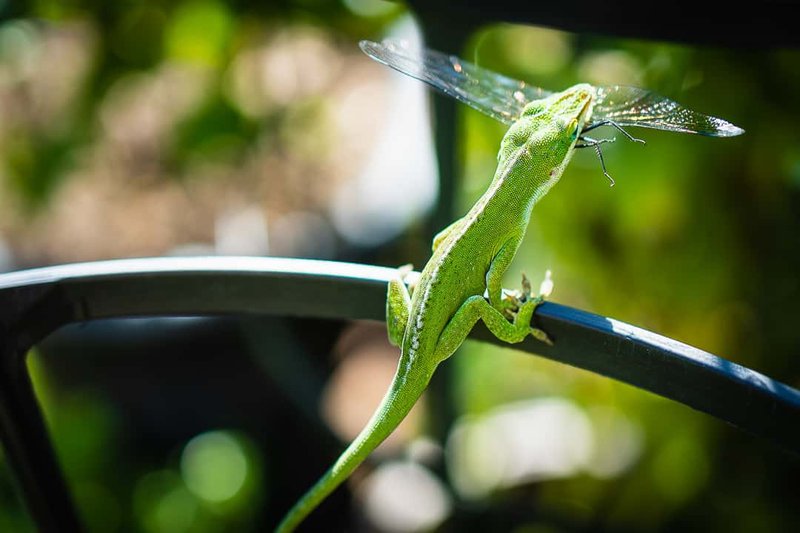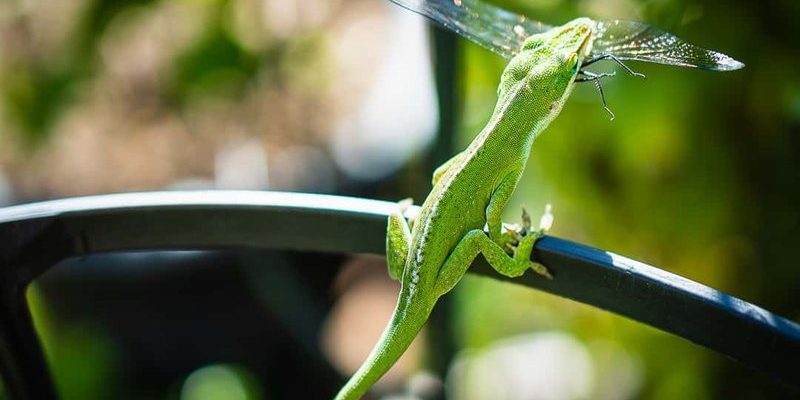
Think of the anole lizard as a miniature predator in a world full of bigger creatures. They’re not just idly basking in the sun; they’re on a mission, using their keen eyesight and agility to hunt for food. Let’s dig into the details of their diet and hunting strategies.
The Anole’s Diet: What’s on the Menu?
You might be wondering, what exactly does an anole lizard eat? These lizards are primarily insectivorous, which means they feast on a variety of insects. Common items on their menu include:
- Flies
- Crickets
- Moths
- Ants
- Beetles
These lizards have a sweet spot for small, soft-bodied insects, which are easier to catch and consume. Picture them as little hunters, waiting patiently for the perfect moment to pounce on their unsuspecting prey. In addition to insects, some species of anole may nibble on plant matter or small fruits, especially if insects are scarce. This flexibility in diet helps them survive in various environments.
How Anoles Hunt: The Art of the Ambush
Now that we know what they eat, let’s explore how they hunt! Anoles are masters of stealth, often using a hunting style similar to an ambush predator. They typically stay still and blend into their surroundings—thanks to their remarkable ability to change color to match their environment. When a juicy insect happens to wander by, the anole springs into action.
Here’s how their hunting technique typically unfolds:
1. Observation: Anoles have excellent eyesight, allowing them to spot movement from a distance. They watch their surroundings carefully, waiting for the right opportunity.
2. Pounce: When an insect is close enough, the anole uses its powerful legs to leap forward. They can jump several times their body length, making them surprisingly agile hunters.
3. Capture: Once they land, they grab their prey with their quick reflexes and sharp teeth. Anoles are not just about speed; their strategy is all about patience and precision.
The Role of Camouflage in Hunting
Camouflage plays a crucial role in anole hunting strategies. These lizards can change their color based on their surroundings, which is similar to how chameleons operate. This skill isn’t just for show; it significantly enhances their hunting success.
When an anole blends into the leaves or bark, it can remain undetected by both its prey and potential predators. Imagine sneaking up on a sandwich while hiding behind a couch—anoles do the same thing in nature!
This tactic not only helps them catch insects but also protects them from bigger animals that might want to make a meal out of them.
The Importance of Location
Where do anoles find their food? The answer lies primarily in their habitat. Anoles thrive in environments with plenty of vegetation, as they prefer areas where they can climb and hide. Gardeners often spot them on trees, shrubs, or even fences.
Their hunting location is crucial because:
– Accessibility of Food: Areas with thick vegetation typically have a high insect population.
– Hiding Spots: Climbing up high gives anoles the perfect vantage point to spot prey from above while remaining concealed.
By choosing the right locations, anoles maximize their chances of finding food while minimizing the risk of being eaten themselves.
Seasonal Changes in Diet
You might not realize this, but anole lizards can change their feeding habits with the seasons. During warmer months, when insects are abundant, these lizards feast on a wide variety of bugs. As the weather cools down, their diet can shift, and they might struggle to find food.
In colder weather, some species enter a state similar to hibernation, slowing down their metabolism. This means they don’t need to eat as often. They may rely on any remaining food sources, including those small fruits or even some dried-up insects.
Understanding these seasonal changes helps us appreciate how adaptable these little lizards are and how they manage to thrive in different conditions.
The Impact of Anoles on Ecosystems
You may be surprised to learn that anoles play a vital role in their ecosystems. By controlling insect populations, they help keep gardens and landscapes healthy and balanced. If you’ve noticed fewer bugs buzzing around your backyard, it could be thanks to these little predators.
Here’s how they contribute:
– Natural Pest Control: Anoles help regulate the populations of insects like mosquitoes, ants, and agricultural pests.
– Food Source for Other Animals: They also serve as a meal for larger predators, such as birds, snakes, and even some mammals.
Their presence in the ecosystem maintains the delicate balance of nature, showcasing how even the smallest creatures can have a big impact.
Final Thoughts on Anoles and Their Hunting Skills
The anole lizard is a fascinating creature with a unique diet and hunting style. From their colorful camouflage abilities to their clever hunting strategies, these lizards are true marvels of nature. It’s amazing to think about how much they contribute to their ecosystems while effortlessly blending into their surroundings.
So, the next time you spot one of these little lizards basking in the sun or darting after an insect, take a moment to appreciate the skill and adaptability that allows them to survive. Honestly, they’re not just cute—they’re essential to the balance of our natural world.

